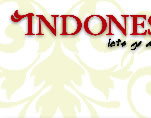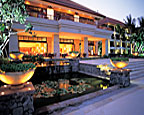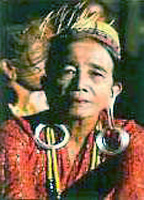










|
|
|||
|
As a major producer of oil and timber, East Kalimantan is at present the most industrially advanced province of the island and the second largest province in Indonesia. It is also the home of the original inhabitants of Kalimantan, the Orang Gunung or Mountain People. The tribes are collectively called Dayak, although this name is not embraced by many tribes-people themselves, who prefer to be known by separate tribal names such as Iban, Punan and Banuaq. Local tribes traditionally live in communal longhouses
called Lamin or Umaq Daru. They are built on wooden piles which
can sometimes be as tall as 3 metres high as protection against
wild animals and flooding. The Punan, however, are nomadic hunter-gatheres,
who still move around the jungles and only use the longhouse at
the height of the rainy season. Steeped in tradition, the interior
of the longhouse is typically divided into separate family quarters
with a communal area connecting each of the quarters and therefore
each of the families. It is in these communal areas that village
meetings are held and ceremonies performed, thereby reinforcing
the strong tribal bonds that have kept the Dayaks alive in the face
of rapidly advancing 20th century technology. Guardian statues are normally placed in front of longhouses to protect them against evil spirits who bring disease and bad fortune. Such longhouses, however, are steadyly disappearing and many that remain have been converted into meeting halls or stages for dance and music performances. The more remote and traditional tribes-people have pierced earlobes, which over the years have become stretched by the weight of heavy gold or brass rings, and beautifully elaborate tattoes. Local jewellery and designs are intricate and powerful, often giving messages to be passed down from generation to generation. The most common starting points for many journeys and adventures inland are Balikpapan and Samarinda, the provincial capital, because of regular flight services to Jakarta. Traveling along the extensive Mahakam river system, which has carved its way through the jungles and flatlands constantly reshaping and nourishing the land, is a fascinating adventure. River boats slide unobtrusively through heavily siltladen waters where plants and animals feed and drink along these nourishing shores, wild orchids drip off trees; Bekantans (Proboscis monkeys), orangutans, crocodiles, clouded leopards, crab eating macaques, giant butterflies and the legendary hornbill all live here. A 5,000 acre Orchid Reservation close to the village of Kersil Luwai cultivates 27 different species of orchid including the very rare Cologenia Pandurata or black orchid.
|
|||
 |
 |
 |
